What’s Your Loren Number?
Posted by: Loren Coleman on March 7th, 2011
The concept of “six degrees of separation” ~ that everyone is linked by six individuals in the world ~ is partial reality, partial academic urban myth. Is this true within the cryptozoology world? What’s your Loren Number?
Many people relate this concept, concretely, to the game “Six Degrees of Kevin Bacon,” which has as the goal to link any actor to Kevin Bacon through no more than six connections, where two actors are connected if they have appeared in a movie or commercial together. This has even been computerized so if you have been in a movie or on television, you can figure out your own Bacon Number via the Oracle of Bacon.



For example, my Bacon Number is 2 (for documentaries/TV), due to this alignment: Loren Coleman was in “Deep Sea UFOs” (2006) (TV) with Will Lyman [who] was in Mystic River (2003) with Kevin Bacon. I am also a #2, due to Loren Coleman was in “Evening Magazine” (1976) {The Bridgewater Triangle} with Matt Lauer [who] was in “Macy’s Thanksgiving Day Parade” (1999) (TV) with Kevin Bacon. If one uses movies alone, my Bacon Number is 3 (for movies), Loren Coleman was in Southern Fried Bigfoot (2007) with Carl Finch [who] was in Late Bloomers (1996) with Angus G. Wynne III [who] was in JFK (1991) with Kevin Bacon.
But 25 years before Kevin Bacon there was Paul Erdős, a Hungarian genius mathematician (March 26, 1913 – September 20, 1996), and the resulting concept of the Erdős number.
The Erdős number describes the “collaborative distance” between a person and mathematician Paul Erdős, as measured by authorship of mathematical papers. It was created by friends as a humorous tribute to the enormous output of Erdős, one of the most prolific modern writers of mathematical papers, and has become well-known in scientific circles as a tongue-in-cheek measurement of mathematical prominence. Erdős numbers have been a part of the folklore of mathematicians throughout the world for many years.
To be assigned an Erdős number, an author must co-write a mathematical paper with an author with a finite Erdős number. Paul Erdős has an Erdős number of zero. Anybody else’s Erdős number is k + 1 where k is the lowest Erdős number of any coauthor.
Here’s how it can be viewed graphically:
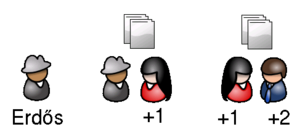
If Alice collaborates with Paul Erdős on one paper, and with Bob on another, but Bob never collaborates with Erdős himself, then Bob is given an Erdős number of 2, as he is two steps from Erdős.
This formula is easy to translate to defining people by their Loren Number. This exercise uses a combination of the Bacon and Erdős criteria, as it will include collaborating “coauthors” and reality programing “co-actors” or “co-interviewees.”
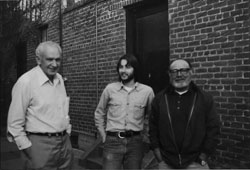
Let’s have a little fun with this, via cryptozoology contributors, reality programming interviewees, and writing collaborators, if you will, linked to me, Loren Coleman. Since I have been in the field for 51 years, I have been called “one of the major popularizers of cryptozoology in the late 20th and early 21st century.” Let’s test it. I have been in many documentaries with several cryptozoologists, experts, and eyewitnesses, and written and contributed to literally dozens of books and articles with coauthors. How far afield does this go? What is your Loren Number?
How are you linked to the cryptozoology and/or Fortean world using me as the starting point, as zero? What is your Loren Number? (Some rules do apply, however. If you merely wrote an article about me or I wrote one about you, those don’t count. You would have to have written/collaborated with me. There are extreme examples of exclusions, for instance, if you are a former girlfriend or ex-wife of mine, that doesn’t count, unless you coauthored an article or book with me or we appeared in a movie or documentary together. Being at the same conference with me or visiting the museum does not count unless we co-presented a paper or did a presentation together. Writing for the same blog does not apply. Being only a Facebook friend is excluded from consideration of a Loren Number, unless the other criteria are met.)
Collaboration is the key.
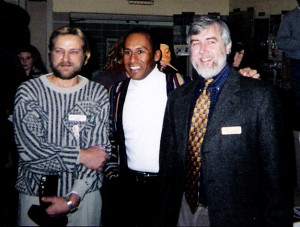

Therefore, below are instances of a few coauthors/co-interviewees/coactors who would all get a Loren Number due to some of these collaborative indicators. One of the best master lists for determining if you are writing collaborator, or then are a #2, #3, or #4, because you are one or have written with one of my collaborators, is to click here. All my articles, hundreds of them, however, are not listed at any one location, yet.
Below are some quick #1s, and then a brief example of one series of linkages.
Loren Number 1: Jerome Clark [coauthor of The Unidentified/Creatures of the Outer Edge (1975, 1978, 2006), Cryptozoology A to Z (1999), and several articles in the 1970s];
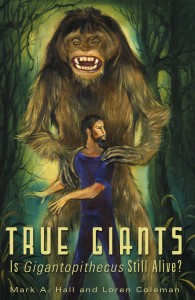
Loren Number 1: Mark A. Hall [coauthor of True Giants: Is Gigantopithecus Still Alive? (2010) and “Some Bigfoot Traditions of the North American Tribes,” in Jacques Bergier’s Le livre de l’inexplicable (1972)];
Loren Number 1: Patrick Huyghe [coauthored The Field Guide to Bigfoot and Other Mystery Primates (1999, 2006) and The Field Guide to Lake Monsters, Sea Serpents and Other Mystery Denizens of the Deep (2003)];
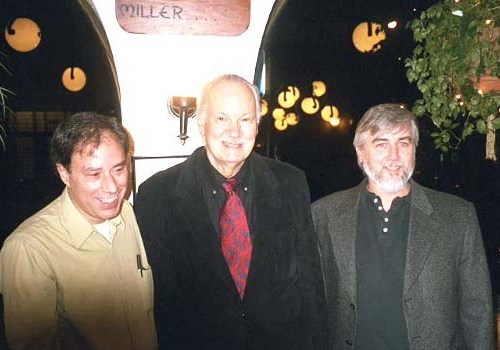
Loren Number 1: John A. Keel [contributed an appendix to Mothman and Other Curious Encounters (2002) and was a co-interviewee in Search for the Mothman (2002)];
Loren Number 1: Craig Woolheater [not because of Cryptomundo, but because of co-appearances in Bigfoot documentaries, e.g. “Weird Travels” & Southern Fried Bigfoot (2007), thus he additionally has a Loren-Bacon number of 2];
Loren Number 1: Bruce Hallenbeck [coauthored Monsters of New Jersey: Mysterious Creatures in the Garden State (2010)].
Therefore, for example, this would be the logic to the next linkages ~
Loren Number 2: Robert B. Bartholomew, Paul Bartholomew, and William Brann [as they coauthored Monsters of the Northwoods (1992) with Bruce Hallenbeck, who has a Loren Number 1.]
Loren Number 3: Hilary Evans [coauthored Outbreak! (2009) with Robert B. Bartholomew, who has a Loren Number 2.]
And on and on it goes, with coauthored works.
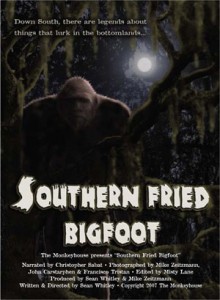
When it comes to documentaries and television reality linkages, the connections are often rapidly apparent via IMDb, although their listings of Loren Coleman appearances is about 20% of what they actually are.

Nevertheless, for example, under the casts and crews for Southern Fried Bigfoot and Search for the Mothman, many Loren Number 1s are revealed.
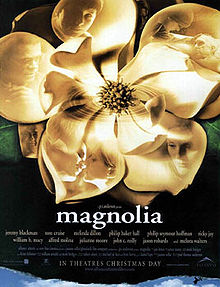
Returning to the theme of “six degrees of separation,” various movies are mentioned on Wikipedia, including the Oscar-winning film, Babel. One that is not noted is a personal favorite of mine, a truly Fortean, fictional depiction of this concept. This would be Magnolia, a 1999 American drama film produced, written, and directed by Paul Thomas Anderson.

The characters in Magnolia are all interconnected, seemingly by coincidence, and joined at the end, somewhat comically and tragically, by a rain of frogs, which is indicated by the film’s frequent Fortean foreshadowing flashed clues. (I have some of the actual prop frogs from this film in the International Cryptozoology Museum, donated by an artist who worked with the motion picture’s special effects department.) I wrote about the Fortean themes of Magnolia in my book, Mysterious America (even though my chapter is fully footnoted at the wikisite, paradoxically, Wikipedia doesn’t link my book to an ISBN number like they do for most references, thus keeping the book quite mysterious).
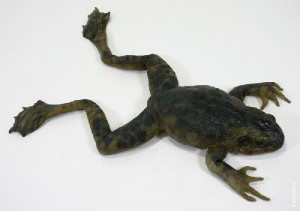
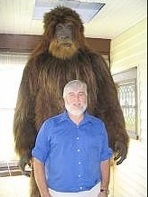
Back to the exercise above, please, in comments below, put your Loren Number, the links you found, and play this “six degrees of separation” cryptozoology impact game.
About Loren Coleman
Loren Coleman is one of the world’s leading cryptozoologists, some say “the” leading living cryptozoologist. Certainly, he is acknowledged as the current living American researcher and writer who has most popularized cryptozoology in the late 20th and early 21st centuries.
Starting his fieldwork and investigations in 1960, after traveling and trekking extensively in pursuit of cryptozoological mysteries, Coleman began writing to share his experiences in 1969. An honorary member of Ivan T. Sanderson’s Society for the Investigation of the Unexplained in the 1970s, Coleman has been bestowed with similar honorary memberships of the North Idaho College Cryptozoology Club in 1983, and in subsequent years, that of the British Columbia Scientific Cryptozoology Club, CryptoSafari International, and other international organizations. He was also a Life Member and Benefactor of the International Society of Cryptozoology (now-defunct).
Loren Coleman’s daily blog, as a member of the Cryptomundo Team, served as an ongoing avenue of communication for the ever-growing body of cryptozoo news from 2005 through 2013. He returned as an infrequent contributor beginning Halloween week of 2015.
Coleman is the founder in 2003, and current director of the International Cryptozoology Museum in Portland, Maine.










Loren, I am a 1, but only in the original Kevin Bacon sense. You went to SIU, and I worked there, possibly at the same time, and I purchased your books to put in the library’s Illinois authors collection of books. [Since they were held in Special Collections where they did not circulate, it was the only way that your books stayed in the library. The ones in the open stacks all got stolen immediately.]
I’ve helped a lot of authors with their work in my day, but none were writing on cryptozoology or related fields, and I don’t know how many went on to link up with other writers you have worked with. I also know some people who were involved in the 1973 Big Muddy Monster sightings, and who wrote about it and are footnoted in your books on Bigfoot.
Sounds like a fun topic!
I’m terrible at these social network games because in real life, I try to never leave the house, I try to never meet anybody.
However I do have one “link” but I don’t know if this even gets a number: On the bookshelf right next to me is an astronomy book called, “The Big Splash,” By Dr. Louis Frank with PATRICK HUYGHE.
That’s about as close as I get to anybody, and it’s about as close as I want to get.